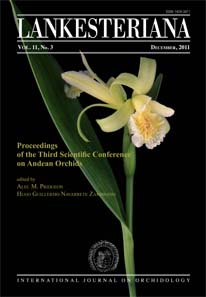Darwin's orchids: their variation, plasticity, and natural selection
DOI:
https://doi.org/10.15517/lank.v11i3.18273Keywords:
Orchidaceae, Charles Darwin, floral variation, deceipt-pollination, natural selectionAbstract
Patterns of variation and their fitness consequences are critical in revealing natural selection. One of the most variable groups of plants are the deception-pollinated orchids, pollinators of which are deceived in their search for a food reward. Negative frequency-dependent selection and disruptive selection have been suggested as the means by which high levels of variation are maintained, yet in most cases such selection has not been detected, prompting alternative explanations including genetic drift. Could phenotypic plasticity cloud the effects of selection? Using a Tolumnia variegata population as a model system, we conducted a reciprocal transplant experiment to determine the effects of light environment on vegetative, inflorescence, and floral characteristics over multiple seasons. The results were complex and showed significant responses to light for most traits measured, but often those changes were obscured by variable responses across years, likely a consequence of dramatically different rainfall. Fruit production was similar for sun and shade sites, but trajectories of selection on a given trait between the two sites were often incongruent. Our data indicated that selection in a heterogeneous environment can indeed be blunted by phenotypic plasticity, but not all characters respond in the same way.
Downloads
Downloads
Published
How to Cite
Issue
Section
License
According to the Open Access policy promoted by the University of Costa Rica, all the papers published by Lankesteriana are licensed under the Creative Commons copyright and can be downloaded free of charge. The journal holds copyright and publishing rights under the CC BY-NC-ND 3.0 CR license.
Before the publication of the materials submitted by the author(s) in LANKESTERIANA, the author(s) hereby assign all rights in the article to the Lankester Botanical Garden.





